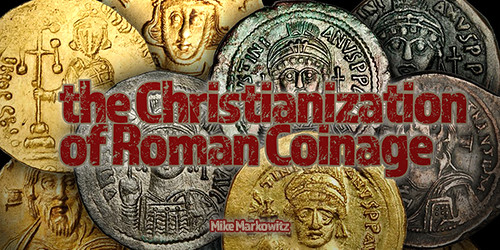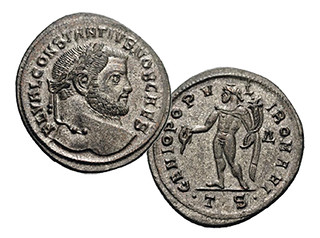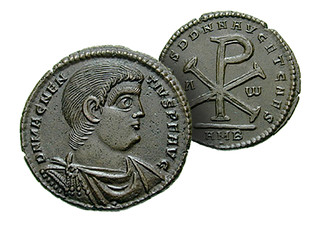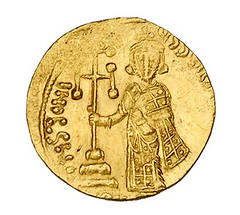
PREV ARTICLE
NEXT ARTICLE
FULL ISSUE
PREV FULL ISSUE
THE CHRISTIANIZATION OF ROMAN COINAGE
Mike Markowitz published a nice article on the Christianization of Roman Coinage in CoinWeek August 19, 2016. Here's an excerpt.
-Editor

BY THE BEGINNING OF THE FOURTH CENTURY CE, the religious life of the Romans was in flux. Inevitably, this was reflected in coinage, where designs often depicted deities. Although the 12 Olympian gods[1] were still venerated in state-funded temples, the common people increasingly practiced a variety of “Eastern” or “mystery” religions. These included worship of the Egyptian goddess Isis; Mithras, a divinity of Persian origin who was especially popular with soldiers; and Serapis, a syncretic “Graeco-Egyptian” god invented by the Ptolemaic dynasty in the third century BCE. And at a certain risk to themselves, a small minority turned to Christianity. For even though pagan polytheism generally accepted imported gods, the growing population of Christians was persecuted or tolerated depending on the whim of the current ruler[2]. Christians (along with the Jewish minority) insisted that there was only one God, all others being either demons or false idols. Participation in official rituals showed allegiance to the state; refusal was a kind of treason.
The article covers a lot of ground; be sure to read the complete version online.
-Editor
Constantine the Great Constantine was directed in a dream to cause the heavenly sign to be delineated on the shields of his soldiers, and so to proceed to battle. He did as he had been commanded, and he marked on their shields the letter X with a perpendicular line drawn through it and turned round at the top … being the cipher of CHRIST… (Lactantius, 203) In gratitude for victory, Constantine adopted the Christian God as his patron, but as a politician and commander, he continued to observe the traditions of his predominantly pagan subjects and soldiers. The Edict of Milan in 313 legalized Christianity throughout the empire, though persecution of Christians had largely ended with the death of Galerius in 311. The first appearance of the Christogram on coinage, datable to 315, is a rare silver miliarensis[6]. The tiny symbol appears on the crest of Constantine’s elaborate jeweled helmet.
Magnentius
Theodosius the Great Theodosius I (“The Great”) decreed that Christianity would be the only legal religion in the Empire (Jews were grudgingly tolerated, with sporadic episodes of official persecution). Remaining pagan temples were closed, and the imperial treasury confiscated their wealth. The eternal fire tended by the Vestal Virgins in Rome was extinguished. The Olympic Games were banned in 393 because athletes competing naked offended Christian sensibilities.
To read the complete article, see:
THE BOOK BAZARREWayne Homren, Editor The Numismatic Bibliomania Society is a non-profit organization promoting numismatic literature. See our web site at coinbooks.org. To submit items for publication in The E-Sylum, write to the Editor at this address: whomren@gmail.com To subscribe go to: https://my.binhost.com/lists/listinfo/esylum All Rights Reserved. NBS Home Page Contact the NBS webmaster 
|


